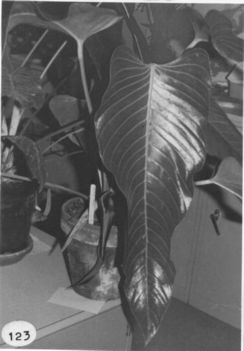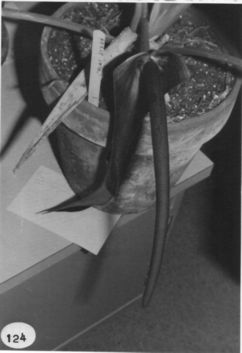





TYPE: Panama. Veraguas: valley of Río Tercero Braso, beyond Escuela Agricola Alto Piedra above
Santa Fe, primary forest along road, 500-700 m, Croat 27329 (MO 2253314, holotype; F, K, PMA, US, isotypes; Live at MO).
Planta epiphytica; ca. 1 m alta; cataphyllum cori-aceum persislens intactum, ultimo deciduum; petiolus quadrangulatus; leviter sulcatus to complanatus adaxialle, 34-74 cm longus; lamina triangulata ad ovato- triangulata, modice coriacea, basi cordata ad subcordata, 46-98 cm longa, 14.5-46 cm lata, nervis primariis lateralis 19-25; inflorescentia effusa; pedunculus 10-35 cm longus, teres; spatha coriacea, pagina interiora purpurea, pagina exteriora viridis, lanceolata, 10-33 cm longa, 2.5-5.5 cm lata, leviter circinata; spadix viridis, lanceolata, 10-33 cm longa, 2.5-5.5 cm lata, leviter circinata; spadix viridis ad violaceo-purpureus, (6-) 18-28 cm longus; baccae aurantiacae, oblongo-ellipticae.
Epiphyte, ca. 1 m tall; stem more than 10 cm long, 4÷6 cm diam.; internodes short; leaf scars conspicuous; roots thick, numerous, green, descending; cataphylls coriaceous, 16-32 cm long, rounded to emarginate at apex with subapical apiculum ca. 5 mm long, drying tan (B & K Yellow-red 9/10), persisting intact, ultimately deciduous.
LEAVES erect to spreading; petioles bluntly to sharply quadrangular, weakly sulcatc to flat adaxially, sometimes 1-ribbed abaxially, 34-74 cm long, 0.7-1 cm wide; geniculum 3-5 cm long, sometimes more conspicuously sulcate than petiole; blades triangular to ovate-triangular, moderately coriaceous, gradually acuminate at apex, shallowly lobed to subcordate at base, 46-98 cm long, 14.5-46 cm wide, broadest in the lower one-fourth of blade; anterior lobe 27-90 cm long, the margins more or less straight to convex; posterior lobes (7-)9-19 cm long (from apex of sinus to outermost point), the outer margin turned up; sinus arcuate to arcuate with petiole decurrent, weakly rounded at apex; upper surface matte to semiglossy, lower surface only slightly paler, semiglossy; midrib flat at base above with an acute medial rib, more acutely raised from about midway to the apex, convexly raised below, conspicuously paler than surface;basal veins 3-5 pairs, often free to the base, the second to fifth sometimes coalesced 1.5-2 cm; primary lateral veins 19-25 per side, departing the midrib at a 50-60° angle, straight to collective vein or weakly arching, prominently raised above, raised below, conspicuously paler than surface above, lesser veins obscure above, visible and flat below; collective vein arising from the first or second basal vein or one of the lowermost primary lateral veins, 1-5 mm from the margin, loop-connecting the primary lateral veins, sunken above.
INFLORESCENCE spreading, shorter than leaves; peduncle 10-35 cm long, 8-10 mm diam., terete, one-half to two-thirds as long as petiole; spathe coriaceous, maroon (B & K Red-purple 2/10) on inner surface, green tinged maroon on outer surface, lanceolate, 10-33 cm long, 2.5-5.5 cm wide, broadest just above point of attachment, reflexed at anthesis and sometimes weakly coiled, long-acuminate and inrolled at apex, rounded to cordate at base, inserted at a 30° angle on peduncle; spadix green to maroon (B & K Red-purple 2/5), tapered toward apex, (6-)18-28 cm long, 1-2 cm diam. at base, 0.8-1 cm diam. at apex; flowers weakly 4-lobed, 2.7-3.2 mm long, 2.9-3.1 mm wide, the sides weakly to jaggedly sigmoid, 13-15 flowers visible in the principal spiral, 12-20 flowers visible in the alternate spiral; tepals matte, conspicuously punctate, minutely papillate, the lateral tepals 0.8-1 mm wide, the inner margins concave to straight;m pistils emergent, green tinged violet purple; stigmas linear, violet purple, 0.6-1 mm long; stamens emerging from the base, the laterals first, quickly followed by alternates, stamens exserted on red-violet filaments 1.4-1.6 mm long, which dry to hold anthers above and slightly over or at sides of pistil; anthers ca. 0.7 mm long, ca. 0.9 mm wide; thecae ovate-oblong, weakly to not at all divaricate; pollen orange, fading to tan.
INFRUCTESCENCE spreading to pendent; spadix to 45 cm long; berries orange, early emergent, oblong-elliptic, acute at apex, the tip relatively blunt; mesocarp with linear to punctiform raph-ide cells; seeds 2, oblong-ellipsoid to ellipsoid, somewhat flattened at least on one side, 4.5-5 mm long, 2.7-3.2 mm wide, 1-1.5 mm thick, rounded to obtuse at base, rounded to emarginate at apex with the radicle protruding; the appendage thin, at apex only (dried berries only were studied). Figs. 123 and 124.
Anthurium nervatum is endemic to Panama in Code, Chiriquí, and Veraguas Provinces at 500 to 1,500 m in tropical wet, premontane rain, and lower montane wet forest life zones.
The species is a member of section Pachyneurium and is recognized by its long, triangular, shallowly lobed to subcordate, moderately thick leaf blades with numerous primary lateral veins, its usually long-tapered green to maroon spadix, and by its lanceolate, coriaceous spathe that is deep maroon on the inner surface, green heavily tinged maroon on the outer surface, and often forms a loose spiral at anthesis. The name refers to the prominent primary lateral veins. It is most easily confused with Anthurium ranchoanum but that species has a shorter spadix with an erect, green spathe and larger flowers with fewer per spiral. It may also be confused with A. colonicum but the species has early exserted, acute pistils and fewer primary lateral veins in the blade.
One collection from El Valle in Code Province (Croat 37443} is probably also this species, but it has a smaller, more ovate-triangular, more coriaceous blade with the posterior lobes sharply turned upward and a deeper sinus; it also has a green rather than maroon spadix.
 |
 |
Map of Mesoamerican specimens with coordinates
Panama Bocas del Toro: Cerro Colorado, 1100-1750 m, 8.35N 81.54W, 27-31
Mar 1986, Barry Hammel & J. Trainer 14919 (MO, PMA).
Panama Chiriquí: Cerro Colorado, 1200-1500 m,, 12 March 1976, Thomas
B. Croat 33145 (DUKE, F, MO, PMA).
Panama Chiriquí: Cerro Colorado, 1690 m,, 15 July 1976, Thomas B. Croat
37177 (MO).
Panama Chiriquí: Cerro Pate Macho, 1700-2100 m,, 26 May 1981, Sytsma
et al. 4830 (MO).
Panama Chiriquí: Cerro Colorado, 1690 m,, 15 July 1976, Thomas B. Croat
37169 (MO, PMA).
Panama Chiriquí: Cerro Colorado, 1200-1500 m,, 14 March 1976, Thomas
B. Croat 33394 (MO, RSA, US).
Panama Chiriquí: Cerro Colorado, 750 m,, 22 Nov. 1979, Thomas B. Croat
48459 (MO).
Panama Chiriquí: Cerro Colorado, 1200-1500 m,, 14 March 1976, Thomas
B. Croat 33305 (MO).
Panama Chiriquí: Cerro Colorado,, , Folsom et al. 4706 (MO).
Panama Chiriquí: Cerro Pate Macho, 1500-1900 m, 8.50N 82.25W, 7 January
1983, Bruce A. Stein Bob Schmalzel and David W. Roubik 1257 (MO).
Panama CoclŽ: Cerro Caracoral,, 24 Apr. 1968, Kirkbride 1096 (MO, NY).
Panama CoclŽ: El Copé Region, 800-900 m,, 20 Apr. 1977, Folsom
& Jaslon 2691 (MO).
Panama CoclŽ: El Copé Region,, 5 Apr. 1978, Hammel 2408 (MO).
Panama CoclŽ: El Copé Region, 750-900 m,, 20 Jan. 1978, Thomas
B. Croat 44717 (MO, PMA).
Panama CoclŽ: El Copé Region, 930 m,, 6 Dec. 1979, Thomas B.
Croat 49169 (MO).
Panama CoclŽ: Cerro Moreno, 130-250 m, 08.46.44N 18.31.54W, 7 Feb 1983,
G. Davidse & C.W. Hamilton 23713 (B, MO).
Panama CoclŽ: Cerro Caracoral,, , Duke & Dwyer 15118 (NY).
Panama CoclŽ: El Valle Region,, , Thomas B. Croat 37443 (CAS, CM, F,
KYO, LE, M, MO, PMA, SAR, US).
Panama Veraguas: Santa Fe Region, 1050-1150 m,, 29 Nov. 1979, Thomas
B. Croat 48912 (MO).
Panama Veraguas: Santa Fe Region, 500-700 m,, 29 Aug. 1974, Thomas
B. Croat 27329 (F, K, MO, PMA, US).
Panama Veraguas: Santa Fe Region, 800-1350 m,, 5 June 1982, Knapp &
Dressler 5446 (MO).
Panama Veraguas: Santa Fe Region, 800-1400 m, 8.32N 81.7W, 20 March
1982, Knapp & Kress 4369 (MO).
Panama Veraguas: Santa Fe Region, 735 m,, 4 Apr. 1976, Thomas B. Croat
33987 (CAS, MO, US).
Panama Veraguas: Santa Fe Region, 1000-1250 m,, 30 Nov 1979, Thomas
B. Croat 48925 (MO, PMA, SEL).
Panama Veraguas: Santa Fe Region, 750-950 m, 8.36N 81.6W, 15 Dec. 1981,
Knapp & Sytsma 2475 (MO).
Panama Veraguas: Santa Fe Region, 1200-1450 m,, 14 May 1981, Sytsma
et al. 4590 (MO).
Panama Veraguas: Santa Fe Region, 800-1350 m, 8.32N 81.7W, 5 June 1982,
Knapp & Dressler 5415 (MO, US).
Panama Veraguas: Santa Fe Region, 500 m,, 5 Apr. 1976, Thomas B. Croat
34244 (MO, PMA).
Panama Veraguas: Santa Fe Region, 735 m,, 4 Apr. 1976, Croat &
Folsom 34134 (MO).
Panama Veraguas: Santa Fe Region, 1150-1450 m, 8.30N 81.10W, 6 February
1988, Gordon McPherson 12070 (MO).
Panama Veraguas: 800-1030 m,, 15 July 1994, Thomas B. Croat & Guanghua
Zhu 76908 (MO).